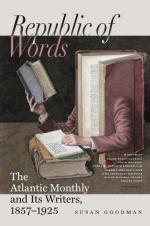The character of Kate Gaunt is treated in the denouement with a violence which almost destroys its identity, but throughout the whole previous progress of the story it is a most artistic and consistent creation. From the beautiful girl, so virginal and dreamy and insecure of her destiny in the world, with her high aspirations and her high temper, there is a certain lapse to the handsome matron united with a man beneath her in mind and spirit, and assured of the commonplace fact that in her love and duty to him is her happiness; but as Love must often mate men and women unequally, it is perfectly natural that Love in her case should strive to keep his eyes shut when no longer blind. Great exigencies afterwards develop her character, and it gains in dignity and beauty from her misfortunes, and we do not again think compassionately of her till she is reunited with Griffith. In spite of all her faults, she is wonderfully charming. The reader himself falls in love with her, and perhaps a subtile sense of jealousy and personal loss mingles with his dissatisfaction in seeing her given up again to her unworthy husband. She should have been left a lovely and stately widow, to whom we could all have paid our court, without suffering too poignantly when Sir George Neville finally won her.
Evangeline, a Tale of Acadie. By HENRY W. LONGFELLOW. With Illustrations by F.O.C. Darley. Boston: Ticknor and Fields.
Maud Muller. By JOHN G. WHITTIER. With Illustrations by W.J. Hennessy. Boston: Ticknor and Fields.
The Vision of Sir Launfal. By JAMES RUSSELL LOWELL. With Illustrations by S. Eytinge, Jr. Boston: Ticknor and Fields.
Flower-de-Luce. By HENRY WADSWORTH LONGFELLOW. With Illustrations. Boston: Ticknor and Fields.
Of these volumes three have long since taken their place in the letters of America, and in the hearts of all who know and love the purest, the truest, and the best that poesy can offer. To them in their secure position will now be added “Flower-de-Luce,”—Mr. Longfellow’s latest volume,—which, containing indeed for the most part only such lyrics as he has already contributed for desultory publication, is yet rich with the fruit of the deep insight, wise thought, earnest feeling, and ripe scholarship of his full maturity.
But it is not our purpose to pause in criticism over works that may fairly be said to have passed beyond the province of contemporary criticism. Rather is it our desire to welcome them as they are tendered to us in a new form, and to commend the artistic character of their presentation. For these books indicate that out of the many attempts which have been made in this country—some of them most creditable, too, and nearly approaching thorough excellence—to produce illustrative and mechanical effects equal to those of England and continental Europe, there has at last come an absolute accomplishment, from which we hope and are ready to believe there will be no recession.




